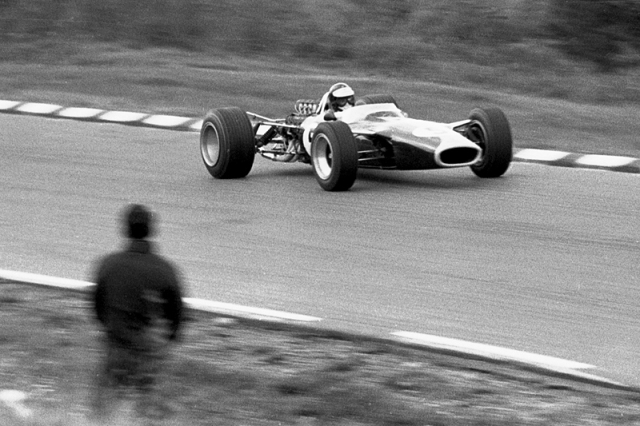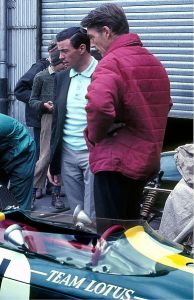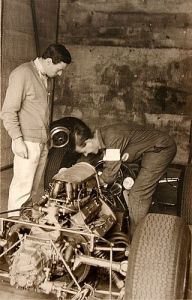
Jim Clark at the 1967 U.S. Grand Prix. (Photo credit: Rtsanderson via Wikimedia Commons)
Yesterday, I published my first longform feature for Bleacher Report. It is the story of 1963 and 1965 world champion Jim Clark’s final Formula One race.
I pitched the story two months ago and my editor was immediately interested. I had been searching for a while for a topic for a longer feature, but everyone in modern F1 is so inaccessible—and the market is so over-saturated with coverage—that I decided to look elsewhere. My degree is in history, so it was natural that I would look to the past.
It has always fascinated me that Jim Clark won his final F1 race (his last three, actually!) before he died at an Formula Two race in Germany. Only one other driver, Luigi Fagioli, won his last F1 grand prix…and his was a shared drive with the great Juan Manuel Fangio (guess which one of them actually took the chequered flag).
One day, I was looking for some info on that last race before Clark’s fatal accident, the 1968 South African Grand Prix, and realised almost nothing had been written about it. That is partly because it was not a particularly significant race at the time—yes, Clark broke Fangio’s record for wins, but everyone expected many more—and partly because the focus naturally fell on the race where Clark died, three months later.
47 years ago the world of #F1 lost Jim Clark—@MatthewWalthert tells the story of his last race http://t.co/sm0sp6ZdhB pic.twitter.com/WFKu9NTUPY
— Bleacher Report UK (@br_uk) April 7, 2015
I quickly figured out that there were only eight drivers still living from the 23 who started the race, so I started tracking them down. Most did not have a ton of vivid memories of the race, but everyone had memories of Clark, even the guys who didn’t know him well.
One of my favourites, which didn’t make it into the final story, was from Basil van Rooyen, a South African driver who was making his F1 debut at his home race. Van Rooyen was at Brands Hatch for a saloon car race and he aquaplaned off the track at Hawthorns Bend, flipping his car on its side.
After climbing out, the next thing Van Rooyen saw was Clark coming around the curve in his famous Lotus Cortina, one hand on the wheel, the other giving a thumbs-up sign to Van Rooyen, checking to make sure he was OK. I could just imagine Clark doing the same thing on the farm roads in Scotland, checking to make sure a neighbour was OK as he drove by.
I ended up talking to five of the eight living drivers for the story. Dan Gurney declined, as he is working on an autobiography and didn’t want to scoop himself. I got one of Jacky Ickx’s representatives to contact him to ask for an interview and he never responded—she said that is not unusual (and had warned me that would probably be the case beforehand), as he is enjoying his retirement. And the last one I did not interview was Jackie Stewart, Clark’s fellow Scot, who—astute businessman that he is—charges for his interviews.
But five out of eight is pretty good—I could go to every F1 race for a year and not get half-an-hour alone with 60 percent of the current drivers.
There were two major challenges for the story. The first was that I wanted to capture some of Jim Clark’s voice, but, as Robert Daley told me, “You could talk to him any time you wanted, but he didn’t have much to say.
“Phil Hill was the best talker of them all and [Stirling] Moss was second…and Clark was down in 25th or something.”
I still managed to get a few good stories, like Clark telling Brian Redman about his exercise regimen, or discussing farming with Chris Amon while they fished off the coast of New Zealand in the last weeks of his life.
Dave Sims, Clark’s mechanic at that fateful F2 race, also had a great story about Jim Clark, talentspotter:
Jimmy came back from America once when he was doing some Indy testing and he said, ‘There’s a guy over there called Mario Andretti. That guy—his car control’s incredible. If he ever goes into F1, he’ll be the world champion.’
And we all laughed at him…’Yeah, yeah. They only turn left over there, you know.’
Jimmy was spot on with that one.
The other problem with reporting this story was that most of the main characters were dead. Clark, obviously, but also his team-mate, Graham Hill, and Lotus boss Colin Chapman. Luckily, I was able to speak with Bob Dance and Tony Rudlin, who were both working for Lotus that weekend.
I re-read two of my all-time favourite stories a couple times while reporting and writing mine: Sebastian Junger’s “The Storm” and Chris Jones’ “Animals”. I found Junger’s piece relevant to my story because all of his protagonists had died by the time he started reporting his story, too. As for Jones, well, I was trying to channel his ability to create and build suspense, even in a story where many of his readers probably knew (or could at least guess) the final outcome.

Jim Clark (in blue) at the 1966 German Grand Prix. (Photo credit: Lothar Spurzem via Wikimedia Commons)
I wrote some of the story as I was still interviewing—the section about the perils of racing in the 1960s, for example, came to me as soon as I heard Daley’s story about Jackie Stewart and his wife. Same with the ending. Brian Redman was one of the first people I interviewed and when he told me how he found out about Clark’s fatal accident, I knew immediately that’s how the story would end.
The lede, on the other hand, changed as I wrote. Originally, I was going to set the scene with what was happening around the world on that New Year’s Day. Then I decided to start right at the beginning of the race, with the tension building immediately. Hopefully it carries right through the story.
To finish this off, here is one final, random memory, courtesy of Andrea de Adamich, who drove for Ferrari in South Africa: “Jim was not very, very slim like the drivers of today. He was with a little bit of meat around his body.”
Grazie, Andrea. Now, get reading!
